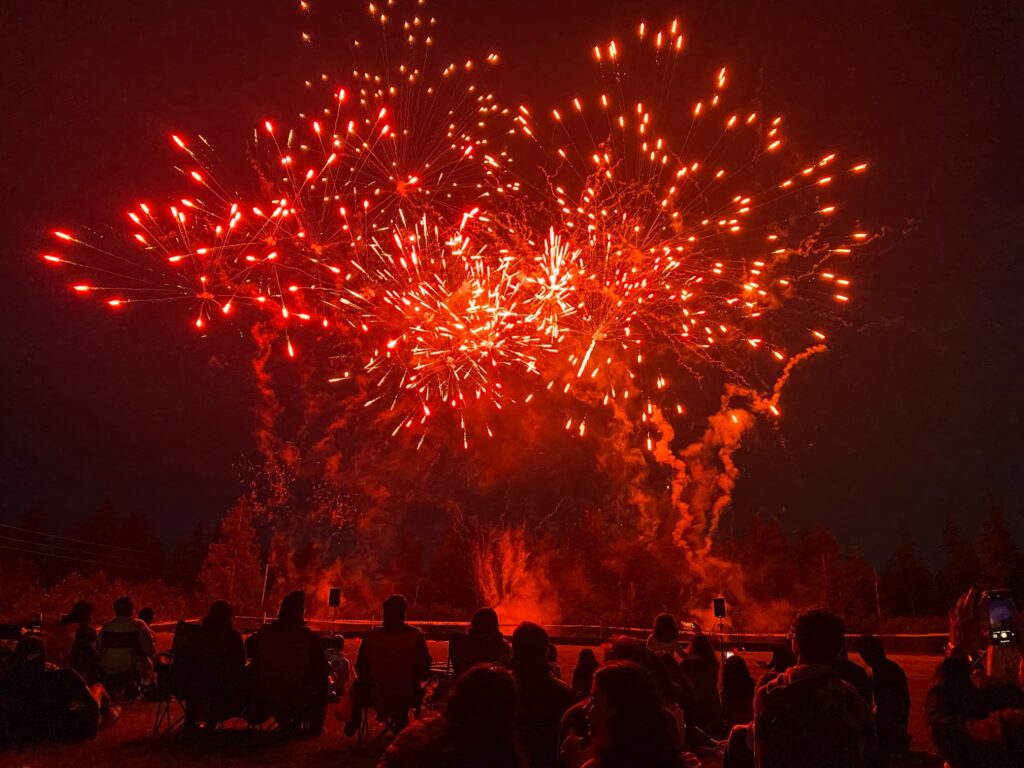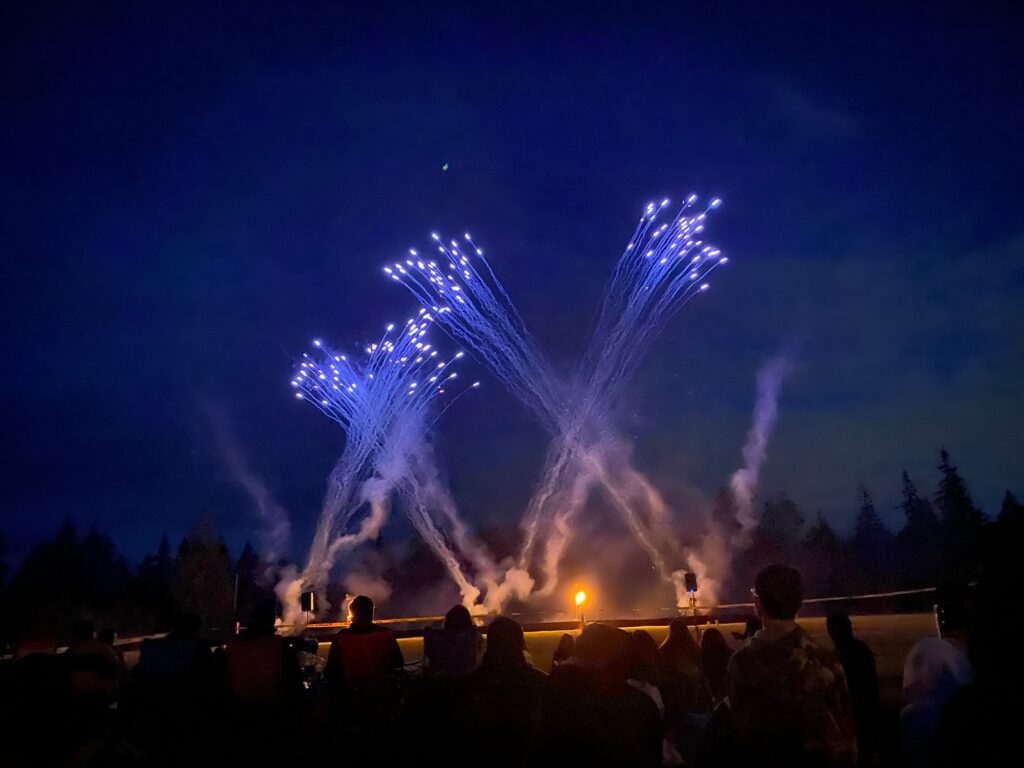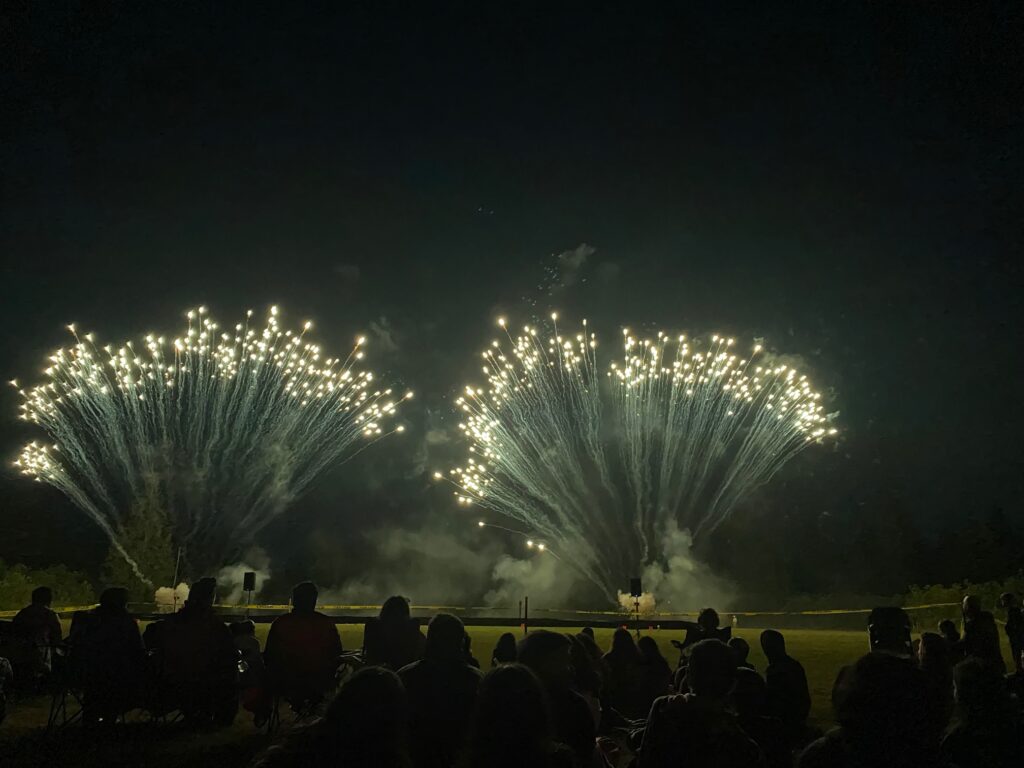
As I sat watching the fireworks explode in the sky above me, I thought of Primary music. (Of course!?)
The firework display was set to 4 different songs. In between each song, the sky went dark before that particular set of the display started up again. One of the displays was especially effective because they sent up booming grandeur lighting the whole sky, then smaller burst of color aimed to the side or in a swirling motion. The variety and change of pace in the fireworks plus the sky going dark every set made all the difference in how it came across to us as an audience.

Both the Variety in the kinds of fireworks used and Change of Pace within the show (contrasting the “light the sky” types with the more gentle “swirl or twinkle” types) made a huge difference in how much the audience appreciated the different fireworks. Having the sky go dark between each set was like a reset for us as an audience so that we could adjust our senses and mindset for another round of fireworks (Kind of like “freeze” or “pause” is used in Primary music!) Using Variety, Change of Pace, and the Power of Freeze principles in Primary Singing Time makes a HUGE difference for the Primary children in how they enjoy singing time!
Primary Singing Time using Variety, Change of Pace, and the Power of Freeze
Let’s set up the singing time in a way that uses Variety and Change of Pace built in as a natural way of teaching, then apply a little sprinkle of the Power of Freeze as we teach.
I explained some of this to my son when he was first called to be a Primary music leader this year when told me he “just didn’t want to die” as he was in front of the children.? Here’s his post: http://teachingprimarymusic.com/surviving-your-first-week-as-a-new-primary-chorister/
This is a summary of what he and I talked about:
- Use 3 different songs that contrast to each other. Already that brings in some variety. For instance, if you have a song that is smooth and gentle, make sure you are also teaching a song that has a strong beat. Why 3 different songs? Children’s attention spans are with you for about 5 to 7 minutes before they need a change…so 3 different songs for 5 to 7 minutes each.
- Use 3 different activities that contrast to one another. Make sure the activities directly relate to the song…beat, rhythm, melody, words, and feel of the song. If you swish and tap a rhythm pattern with pool noodles or rhythm sticks, contrast that with a put the pictures in order for younger or an envelope game for older. (Hint: always use at least one activity that taps, shakes, or swishes to the beat. Children need to move.)
- Occasionally call out “Freeze” and direct the children’s attention to some part of the activity. It helps the children to reset themselves, pull their attention back to the song and activity, and to control themselves (which is a developmental task at all ages of Primary and “Freeze” helps them practice and develop this skill).
You might also want to read over this post: http://teachingprimarymusic.com/just-got-called-as-a-primary-music-teacher/
Variety
Because you are using 3 contrasting songs and each of those songs have an activity that is different from each other, you are set up nicely for variety.
Here are some tips:
Use one song activity with movement, one song activity with a puzzle of some sort, and perhaps one song activity with images. (At times I use two movement activities and one other type of activity when I can sense the children need to move.)
The images could be hand signs http://teachingprimarymusic.com/i-love-to-see-the-temple-hand-signs/, Silent Video http://teachingprimarymusic.com/if-the-savior-stood-beside-me-silent-video/, a concentration match it game http://teachingprimarymusic.com/if-i-listen-with-my-heart-2nd-verse-concentration-match-it-game/ or http://teachingprimarymusic.com/picture-concentration-matching-game-younger-i-belong-to-the-church-of-jesus-christ/, a literal 3 or 4 piece set of puzzles with images from the song http://teachingprimarymusic.com/three-piece-puzzle-activity-for-younger-children-i-know-that-my-savior-loves-me/, or hand drawn stick figures http://teachingprimarymusic.com/as-a-child-of-god-draw-the-song/.
For older children, the puzzle could be Crack the Code, Envelope Game, Eraser Pass, or Put the words in order. The puzzle for younger children could be how many times do we clap our hands (lap, shoulders, etc.), or which of these pictures are matches, or what action do we do on this word.
The movement pattern can literally be with any of 10 different “tools” we can use to help tap out the beat or rhythm (which brings even more variety).
Note: I often will do two different kinds of movement patterns (perhaps one with wind wands, and one with egg shakers) as two of the activities, especially if I am working with younger children.
Change of Pace
Some of the fascination of waves of the sea coming onto a beach is that there are some waves that crash and come way up on the beach, some waves that are gentle, and some waves just in between. The change of pace is so good for our well being!

So it is with Primary music. We need:
A High Intensity Activity for 5 minutes, A Change of Pace, and a Medium Intensity Activity for 5 minutes (and it doesn’t necessarily have to be in that order.)

If you are shooting off booming, light the sky fireworks for a full 30 seconds, then change the pace and do more delicate, lower key fireworks! (It will be more effective.)
Likewise for the activities in Primary Singing Time.
If I have something the children are really concentrating on (High intensity),
which for Older children might be Color Code http://teachingprimarymusic.com/i-am-a-child-of-god-color-code-for-older-children-3rd-verse/, Crack the Code (an activity where you list the first letter of each word by phrases, put them our of order, then ask the children to put them in order as you sing), Envelope Game http://teachingprimarymusic.com/nephis-courage-verse-1-envelope-game-for-older-children/, or another puzzle.
and for Younger children might be learning the hand signs for a new song or putting the pictures in order http://teachingprimarymusic.com/heavenly-father-loves-me-whenever-i-hear-the-song-of-a-bird/,
…my brain as an adult can keep that high concentration for about 10 minutes, then it needs a change of pace. Same with children…but only it is about every 6 to 7 minutes.
Change the Pace with a contrasting song and a different type of activity that doesn’t require quite so much brain power. (I usually use an easier movement activity and a strong beat song.)
The Power of Freeze
One of the most effective ways to help the children center themselves and pay attention during an activity is to call out “Freeze.” (Sometimes I literally have to call it out about two or three times to help a child pull their attention back to me.) As the children are “frozen,” you then have the chance to direct their attention back to a detail of the activity.
With younger children Sway and Freeze, I often ask “Is your foot pointed just like mine? Are your hands going this direction? We then start right back into the movement activity. http://teachingprimarymusic.com/well-bring-the-world-his-truth-sway-and-freeze-for-younger-children/ or http://teachingprimarymusic.com/jesus-once-was-a-little-child-sway-and-freeze-for-younger-children/
During the freeze moment with older children, I often ask “What word do we sing when we patsch with the pool noodles (tapping on our lap)? Or “How many times do we say the word Spirit in this song?” Or “What is the highest note in this song?” Because of their developmental level, older children need to solve puzzles and gather clues. This kind of questioning right in the middle of an activity meets their need for this.

Anne Maughan
Thank you so much for taking the time to share these ideas with everyone. I went to your workshop in Walla Walla, and it’s good to have these reminders, along with the links to help. Thanks again for your love of Primary music and the children.
Edyth Lang
These principles are the basic keys to success during any singing time. I believe that competition and games have their place in a child’s world but probably not during singing time.